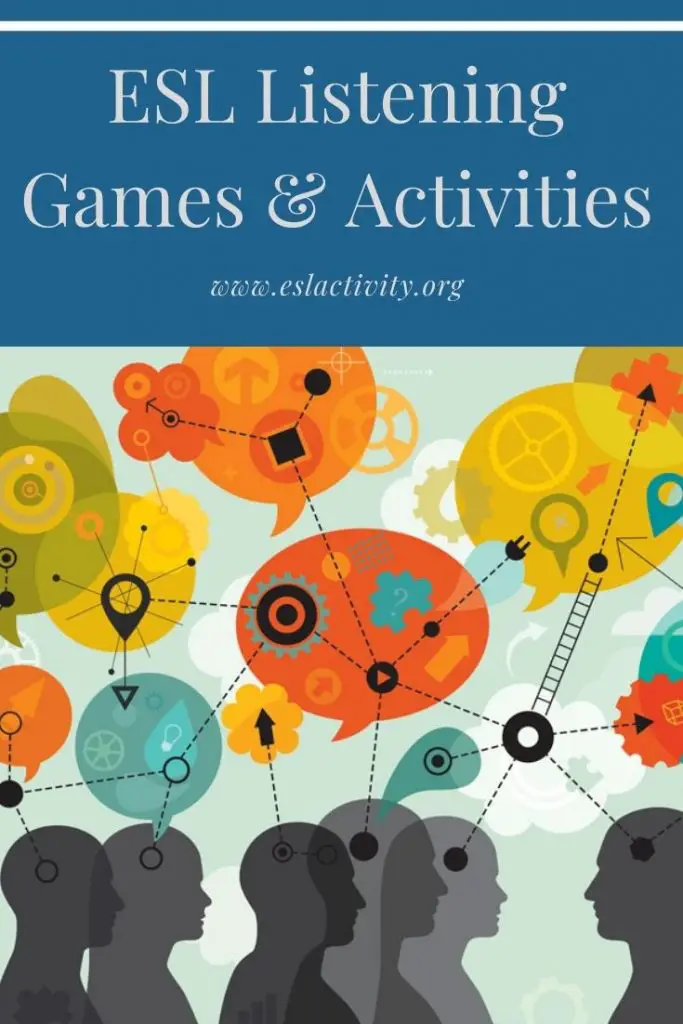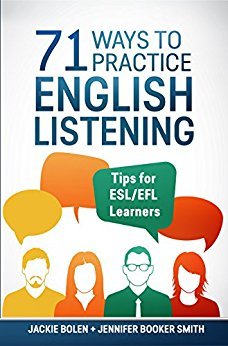EasIf you’re looking for some of the best ESL listening activities and games, then you’re certainly in the right place. Keep on reading for some of the best ELL listening activities, along with tips and tricks for English learners to improve their listening skills.

ELL listening activities
ESL Listening Activities and Games
Do you want to improve your English listening? Then you’re in the right place! Keep on reading for this tip about listening for one specific thing. It can help you not become overwhelmed when it’s something a bit difficult.
#1: The Flyswatter ESL Listening Game
I love to use this ESL listening game when I want to have some fun with my students. Write a bunch of works on the board related to whatever vocabulary set or grammar point you’re teaching. Then, there are a number of things you can do, depending on the level:
- Say the word and students have to find it
- Give hints about the word
- Start a sentence and students have to finish it with a word on the board
- Etc.
Find out all the options for one of the best ELL listening games here:
#2: Dictogloss ELL Listening Activity
Try out this challenging listening ESL activity for higher-level students. Find, or write a passage containing lots of examples of whatever the target grammar or vocabulary is.
Then, put students into pairs and read it out at a faster than normal pace for the level of the students. The students have to take notes and then attempt to recreate what they heard with their partner. Read it out again and students do the same thing. In the end, they compare what they have with the original. Find out more here:
#3: Dictation Practice
Okay, so I know that dictation is kind of old school but it does certainly have some value as a listening exercise for English learners. Find, or write a passage to read out loud to the students. They have to listen and write down what they hear. This activity helps students with:
- punctuation
- capitalization
- listening skills
- writing skills
- spelling
- grammar
- vocabulary
In short, it’s a very versatile activity! To make it even more challenging, dictate some questions and have students write the answers, or vice-versa. Find out more here:

#4: Does it Match?
Try out this very simple ELL listening activity with your students. It’s a nice warmer activity or as a time-filler at the end of class.
Write down a sentence on the whiteboard or on a PowerPoint slide. Then, read a sentence out loud and students have to decide if it’s the same thing they just read. If it’s not the same, they have to say what is different.
- Amazon Kindle Edition
- Bolen, Jackie (Author)
- English (Publication Language)
- 116 Pages - 02/02/2020 (Publication Date)
#5: Reported Speech ESL Activities and Games
Reported speech, by its very nature, involves listening. Students have to listen to what someone says and then report this information to another person. There are lots of activities to consider trying out. Here are some of the best ones:
ESL Reported Speech Activities.
#6: Running Dictation
#7: Man/Woman on the Street Interview Activity
A nice way to have students work on their listening skills is to have them talk to other students. However, it can certainly get a little bit boring to just tell students to talk to their partner about ABC for 3 minutes.
To mix things up a bit, consider doing this interview activity. It’s a fun way to elicit opinions or facts from students in a more interesting way. Have a look at it here:
Man/Woman on the Street Interview Activity.
#8: Mystery Box
The Mystery Box is a simple ESL listening activity for kids. Put some objects in a box. Then, make a slot on the top so that students can feel what’s inside the box but not see the objects. One at a time, ask students to find an object that meets a certain description. For example, choose something that is…
- long
- small
- soft
- hard
- fuzzy
- etc.
#9: Me Too!
This is a nice warmer activity that focuses on listening and speaking. Each student has to say a true statement about themselves. For example:
- I have two brothers.
- I don’t like vegetables.
Then, students listen and if they’re the same, they have to say, “Me too!” and raise their hands or stand up. Learn more:
#10: Board Games
I love to play board games which is maybe why I like using them so much in my classes. Plus, they’re a great activity that can be tailored to just about any grammar point or vocabulary set.
It’s also ideal for listening. Students have to listen to their classmates’ answers to decide if they’re correct, or incorrect. I’m not sure I’ve ever seen students listening so intently to what their classmates are saying before!
Find out all the details you need to know about using this activity in class:
- Amazon Kindle Edition
- Bolen, Jackie (Author)
- English (Publication Language)
- 123 Pages - 06/05/2020 (Publication Date)
#11: Word Challenge Spelling Game
Try out this fun spelling game that’s also heavy on listening skills. Divide students into teams, depending on how much whiteboard space you have. Then, one student from each team has to write down the word that you say on the board. The first student to do it correctly gets a point for their team. Check it out:
ESL Word Challenge Spelling Game.
#12: Dialogue Substitution
#13: ESL Surveys
Just ask my students and they’ll tell you that I LOVE to use surveys and questionnaires in my classes. They’re ideal because they can be used for just about any topic and they also cover a range of skills in a single activity, including listening. Plus, they get sleepy students out of their seats and moving around the classroom.
Want to try one out in your class? Learn more:
ESL Surveys and Questionnaires.
#14: Closest in Meaning
This is an ESL reading activity, but it also works well for listening. Instead of having students read the sentences, read them out loud instead.
Write a target sentence. Then, make three other sentences, one of which is very similar to the original one, while the other two are not. Find out more about it here:
#15: ESL Listening Comprehension Exercises
There are lots of great listening comprehension exercises on YouTube to consider using in class. They range from easy to advanced and are a nice addition to any lesson plan. Have a look and you’re sure to find something that’ll work for your students.
#16: Round Robin Story
Check out this simple speaking and listening activity where students work together to make a story.
#17: Debate
A nice way to focus on listening in class is to have a debate. There are a ton of fun topics for all ages. Have a look at these two articles for some of the best ideas:
#18: Show and Tell
This is a speaking-focused activity that can also be heavy on listening if you require that students ask follow-up questions. Check out this video to find out how I use it in my ESL/EFL classes:
#19: Gap-Fill Exercises
Provide students with a transcript of an audio clip or dialogue with certain words or phrases missing. Have them listen to the audio and fill in the gaps with the missing information. This activity helps reinforce vocabulary, grammar, and listening comprehension.
#20: Authentic Audio Materials
Use authentic audio resources such as podcasts, news clips, interviews, or TED Talks. Provide students with a specific task or question to focus on while listening. Afterward, engage in a discussion or comprehension-based activity related to the audio material.
#21: Role-Plays
Prepare dialogues or scenarios that require students to listen carefully and respond appropriately. Divide the class into pairs or small groups, assign roles, and have them act out the dialogue. This activity enhances listening skills while promoting speaking and interactive communication. Here are some ESL role-play ideas.
#22: Note-Taking
Play an audio clip or a short video, and ask students to take notes on the main points or specific details they hear. Afterward, have a class discussion or a comprehension activity based on their notes. This activity enhances listening, note-taking, and summarizing skills.
#23: Information Gap
Create an information gap task where students work in pairs or groups, with one student having certain information and the other(s) missing that information. The students with information must listen carefully and convey it accurately to their partner(s). This activity improves listening and communication skills.
#24: Picture Descriptions
Provide students with a series of pictures or visual prompts and play an audio clip describing the images. Students listen and match the audio description to the corresponding pictures. This activity strengthens listening comprehension and visual association.
#25: Songs and Lyrics
Choose songs with clear and understandable lyrics. Play the song and provide students with a copy of the lyrics. Have them listen and follow along, filling in missing words or discussing the meaning of specific phrases. Songs help improve pronunciation, vocabulary, and rhythm in a fun and memorable way.
#26: Storytelling
Play an audio recording of a short story or narrative. Afterward, ask students comprehension questions or have them retell the story in their own words. This activity enhances listening comprehension and storytelling abilities.
#27: News Discussions
Select a current news article or segment related to a topic of interest. Play the audio or video clip, and have students listen and discuss their opinions or thoughts on the topic. This activity improves listening skills while encouraging critical thinking and speaking.
ESL Listening Lesson Plans
If you’re a teacher, then you’ll know what a timesaver it can be to just print off another teacher’s lesson plan and take it to class. Here are some of the top ones that I recommend:
My Life! Teaching in a Korean University
Or, find out how you can plan your own ESL listening lesson based on any topic right here:
Online Listening Activities for ESL
If my students ask for some suggestions about how they can improve listening skills outside of my class, here are some of the websites that I recommend:
How Can I Improve my English Listening Skills?
If you’re studying English, I’m sure you want to improve your English listening skills. English listening is important for a whole lot of reasons to give a good answer in response to a question, to be able to understand a TV show or movie, or even to get a better score on an English proficiency test.
Whatever the reasons for improving your English listening skills, here’s a simple tip to help you do that. It will help you not get overwhelmed but instead focus on something smaller than understanding every single word.
Listen for Just 1 Thing
When you’re a beginner or intermediate student, it can be really useful to listen for only one specific thing. This way, you won’t get overwhelmed, like you would if you were trying to listen to too many details at once. Start small, and work your way up to bigger and better things!
Keep on reading for the English listening tip.
English Listening Tip: Listen for One Specific Thing
Choose an audio that is over five minutes long and listen carefully for one specific aspect of the language. Some things you could listen for include the following:
Sentence/ Word Stress
Modal verbs
Intonation
Numbers
Articles
Tense
Subject-verb agreement
You can listen for whatever you want. Just be sure it’s clear before you start.
- Amazon Kindle Edition
- Bolen, Jackie (Author)
- English (Publication Language)
- 49 Pages - 03/04/2017 (Publication Date)
Start Small with English Listening
If you find that five minutes is too long and your attention starts to wander, start shorter. Like exercising a muscle, you must build up endurance. Here is one activity you can use to practice any of the above with YouTube or any podcast with a transcript. Breaking News English would be perfect for this if you don’t look at the transcript first!
1. Choose a short video or audio clip.
2. Look at the title and think about what the topic is likely to be and what vocabulary you might hear.
3. Listen or watch (without subtitles or transcripts!) several times. Write down the words you are focusing on. For example, if you are focusing on stress, you will write down the stressed words. If you are focusing on articles, write down the noun phrases you hear (“a man” or “the storm”).
4. You can stop and check what you have written using the transcripts or subtitles.
5. If you are using Breaking News English, you can continue listening a few more times, until you are ready to complete the listening activities for a more complete listening study session. Alternatively, you could use the dictation activity and listen very closely to extremely short segments of text.
Teaching ESL Listening FAQs
There are a number of common questions that people have about teaching ESL listening. Here are the answers to some of the most popular ones.
What are the techniques for teaching listening skills?
The techniques for teaching listening skills to English learners are through the use of audio files and video clips with speaking, answering questions after listening to a text, dictation, listening to songs, and more.
What does it mean to teach listening?
Teaching listening involves helping students identify and understand what other people are saying. This involves various layers of understanding, including pronunciation/accent, grammar, vocabulary and finally, the meaning of the utterance.
How can I teach listening to higher-level English learners?
What are the activities for listening?
There are various games and activities that can be used to teach listening, including the following:
- dictation
- secret message
- blindfold walk
- comprehension questions
- listening to songs or podcasts
- putting things in order
- asking follow-up questions to a partner
How can I assess students’ listening skills in ESL?
You can assess listening skills through tasks such as comprehension questions, gap-fill exercises, dictation, note-taking, or by observing students’ ability to follow instructions or engage in conversational exchanges.
Should I use authentic materials for teaching ESL listening?
Yes, using authentic materials like podcasts, videos, or real-life recordings exposes students to natural language, different accents, and cultural contexts, making their listening practice more authentic and relevant.
How can I support ESL students who struggle with listening?
Offer scaffolding by providing pre-listening activities, using visuals, simplifying language when necessary, providing transcripts or captions, and offering opportunities for extra practice or review.
Is it important to teach listening skills alongside other language skills in ESL?
Yes, listening skills are interconnected with other language skills like speaking, reading, and writing. Integrating listening activities in conjunction with these skills promotes well-rounded language development.
How do you introduce a listening activity?
You can introduce a listening activity by first setting the context. Then, do a pre-listening task, a during-listening task, and finally, a post-listening task.
Need more English Listening Tips?
If you liked this ESL listening tip, and need more, then you’ll need to check out this book on Amazon: 71 Ways to Practice English Listening: Tips for ESL/EFL Learners This tip about listening for one specific thing is from the book, and there are 70 more useful tips.
If the book doesn’t help you to improve your listening skills, get in touch and I’ll refund your money. It really is that good!
The key to staying motivated with learning English is to mix up the activities you’re doing. Nobody likes doing the same old thing all the time, right? Right.
That’s why we wrote this book. We wanted to give you some fresh, new ideas for ways that you can work on your listening skills. There are things you can do with a friend, things on your own, or things with a big group of people. The possibilities really are endless for the things that you can do.
Get started today! Pick up your copy.
Where Can I Get It?
They’ll help you improve your English listening skills, whether you’re a beginner, intermediate or advanced level student. Head over to Amazon to pick up your copy today.
The book is available in both print and digital formats. Keep a copy on the bookshelf in your office as a handy reference guide. Or, read the e-version on the bus or subway when you’re going to school or work.
It really is that easy to improve your English listening skills. Ready to get started? Check out the book here:
—>71 Ways to Practice English Listening<—
Have your Say about ESL Listening Activities
What are your thoughts about these listening activities ESL? Do you have another one that you’d like to add to the list? Please leave a comment below and let us know what you think. We’d love to hear from you.
Also be sure to give this article a share on Facebook, Twitter, or Pinterest. It’ll help other busy English teachers, like yourself find this useful resource.
Last update on 2022-07-17 / Affiliate links / Images from Amazon Product Advertising API








